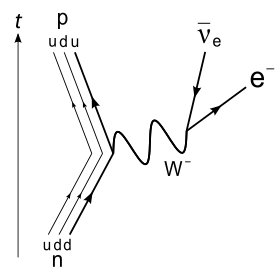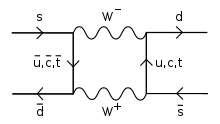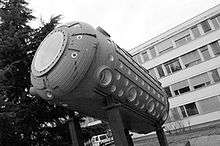W and Z bosons
The W and Z bosons are together known as the weak or more generally as the intermediate vector bosons. These elementary particles mediate the weak interaction; the respective symbols are
W+
,
W−
, and
Z0
. The
W±
bosons have either a positive or negative electric charge of 1 elementary charge and are each other's antiparticles. The
Z0
boson is electrically neutral and is its own antiparticle. The three particles have a spin of 1. The
W±
bosons have a magnetic moment, but the
Z0
has none. All three of these particles are very short-lived, with a half-life of about 3×10−25 s. Their experimental discovery was pivotal in establishing what is now called the Standard Model of particle physics.
| Composition | Elementary particle |
|---|---|
| Statistics | Bosonic |
| Interactions | Weak interaction |
| Theorized | Glashow, Weinberg, Salam (1968) |
| Discovered | UA1 and UA2 collaborations, CERN, 1983 |
| Mass | W: 80.379±0.012 GeV/c2[1]
Z: 91.1876±0.0021 GeV/c2[2] |
| Decay width | W: 2.085±0.042 GeV/c2[1]
Z: 2.4952±0.0023 GeV/c2[2] |
| Electric charge | W: ±1 e Z: 0 e |
| Spin | 1 |
| Weak isospin | W: ±1 Z: 0 |
| Weak hypercharge | 0 |
The
W
bosons are named after the weak force. The physicist Steven Weinberg named the additional particle the "
Z
particle",[3] and later gave the explanation that it was the last additional particle needed by the model. The
W
bosons had already been named, and the
Z
bosons were named for having zero electric charge.[4]
The two
W
bosons are verified mediators of neutrino absorption and emission. During these processes, the
W±
boson charge induces electron or positron emission or absorption, thus causing nuclear transmutation.
The
Z
boson mediates the transfer of momentum, spin and energy when neutrinos scatter elastically from matter (a process which conserves charge). Such behavior is almost as common as inelastic neutrino interactions and may be observed in bubble chambers upon irradiation with neutrino beams. The
Z
boson is not involved in the absorption or emission of electrons or positrons. Whenever an electron is observed as a new free particle, suddenly moving with kinetic energy, it is inferred to be a result of a neutrino interacting directly with the electron, since this behavior happens more often when the neutrino beam is present. In this process, the neutrino simply strikes the electron and then scatters away from it, transferring some of the neutrino's momentum to the electron.[lower-alpha 1]
Basic properties
These bosons are among the heavyweights of the elementary particles. With masses of 80.4 GeV/c2 and 91.2 GeV/c2, respectively, the
W
and
Z
bosons are almost 80 times as massive as the proton – heavier, even, than entire iron atoms.
Their high masses limit the range of the weak interaction. By way of contrast, the photon is the force carrier of the electromagnetic force and has zero mass, consistent with the infinite range of electromagnetism; the hypothetical graviton is also expected to have zero mass. (Although gluons are also presumed to have zero mass, the range of the color force is limited for different reasons; see color confinement.)
All three bosons have particle spin s = 1. The emission of a
W+
or
W−
boson either raises or lowers the electric charge of the emitting particle by one unit, and also alters the spin by one unit. At the same time, the emission or absorption of a
W±
boson can change the type of the particle – for example changing a strange quark into an up quark. The neutral Z boson cannot change the electric charge of any particle, nor can it change any other of the so-called "charges" (such as strangeness, baryon number, charm, etc.). The emission or absorption of a
Z0
boson can only change the spin, momentum, and energy of the other particle. (See also weak neutral current.)
Weak nuclear force

W−
boson
The
W
and
Z
bosons are carrier particles that mediate the weak nuclear force, much as the photon is the carrier particle for the electromagnetic force.
W bosons
The
W±
bosons are best known for their role in nuclear decay. Consider, for example, the beta decay of cobalt-60.
This reaction does not involve the whole cobalt-60 nucleus, but affects only one of its 33 neutrons. The neutron is converted into a proton while also emitting an electron (called a beta particle in this context) and an electron antineutrino:
Again, the neutron is not an elementary particle but a composite of an up quark and two down quarks (udd). It is in fact one of the down quarks that interacts in beta decay, turning into an up quark to form a proton (uud). At the most fundamental level, then, the weak force changes the flavour of a single quark:
which is immediately followed by decay of the
W−
itself:
W−
→
e−
+
ν
e
Z bosons
The
Z0
boson is its own antiparticle. Thus, all of its flavour quantum numbers and charges are zero. The exchange of a
Z
boson between particles, called a neutral current interaction, therefore leaves the interacting particles unaffected, except for a transfer of spin and/or momentum.[lower-alpha 2]
Z
boson interactions involving neutrinos have distinct signatures: They provide the only known mechanism for elastic scattering of neutrinos in matter; neutrinos are almost as likely to scatter elastically (via
Z
boson exchange) as inelastically (via W boson exchange).[lower-alpha 3] Weak neutral currents via
Z
boson exchange were confirmed shortly thereafter (also in 1973), in a neutrino experiment in the Gargamelle bubble chamber at CERN.[7]
Predicting the W and Z

W
bosons. This is one of the leading terms contributing to neutral Kaon oscillation.
Following the success of quantum electrodynamics in the 1950s, attempts were undertaken to formulate a similar theory of the weak nuclear force. This culminated around 1968 in a unified theory of electromagnetism and weak interactions by Sheldon Glashow, Steven Weinberg, and Abdus Salam, for which they shared the 1979 Nobel Prize in Physics.[8][lower-alpha 3] Their electroweak theory postulated not only the
W
bosons necessary to explain beta decay, but also a new
Z
boson that had never been observed.
The fact that the
W
and
Z
bosons have mass while photons are massless was a major obstacle in developing electroweak theory. These particles are accurately described by an SU(2) gauge theory, but the bosons in a gauge theory must be massless. As a case in point, the photon is massless because electromagnetism is described by a U(1) gauge theory. Some mechanism is required to break the SU(2) symmetry, giving mass to the
W
and
Z
in the process. The Higgs mechanism, first put forward by the 1964 PRL symmetry breaking papers, fulfills this role. It requires the existence of another particle, the Higgs boson, which has since been found at the Large Hadron Collider. Of the four components of a Goldstone boson created by the Higgs field, three are absorbed by the
W+
,
Z0
, and
W−
bosons to form their longitudinal components, and the remainder appears as the spin 0 Higgs boson.
The combination of the SU(2) gauge theory of the weak interaction, the electromagnetic interaction, and the Higgs mechanism is known as the Glashow–Weinberg–Salam model. Today it is widely accepted as one of the pillars of the Standard Model of particle physics, particularly given the 2012 discovery of the Higgs boson by the CMS and ATLAS experiments.
The model predicts that
W±
and
Z0
bosons have the following masses:
where is the SU(2) gauge coupling, is U(1) gauge coupling, and is the Higgs vacuum expectation value.
Discovery

Unlike beta decay, the observation of neutral current interactions that involve particles other than neutrinos requires huge investments in particle accelerators and detectors, such as are available in only a few high-energy physics laboratories in the world (and then only after 1983). This is because
Z
bosons behave in somewhat the same manner as photons, but do not become important until the energy of the interaction is comparable with the relatively huge mass of the
Z
boson.
The discovery of the
W
and
Z
bosons was considered a major success for CERN. First, in 1973, came the observation of neutral current interactions as predicted by electroweak theory. The huge Gargamelle bubble chamber photographed the tracks of a few electrons suddenly starting to move, seemingly of their own accord. This is interpreted as a neutrino interacting with the electron by the exchange of an unseen
Z
boson. The neutrino is otherwise undetectable, so the only observable effect is the momentum imparted to the electron by the interaction.
The discovery of the
W
and
Z
bosons themselves had to wait for the construction of a particle accelerator powerful enough to produce them. The first such machine that became available was the Super Proton Synchrotron, where unambiguous signals of W bosons were seen in January 1983 during a series of experiments made possible by Carlo Rubbia and Simon van der Meer. The actual experiments were called UA1 (led by Rubbia) and UA2 (led by Pierre Darriulat),[9] and were the collaborative effort of many people. Van der Meer was the driving force on the accelerator end (stochastic cooling). UA1 and UA2 found the
Z
boson a few months later, in May 1983. Rubbia and van der Meer were promptly awarded the 1984 Nobel Prize in Physics, a most unusual step for the conservative Nobel Foundation.[10]
The
W+
,
W−
, and
Z0
bosons, together with the photon (
γ
), comprise the four gauge bosons of the electroweak interaction.
Decay
The
W
and
Z
bosons decay to fermion pairs but neither the
W
nor the
Z
bosons have sufficient energy to decay into the highest-mass top quark. Neglecting phase space effects and higher order corrections, simple estimates of their branching fractions can be calculated from the coupling constants.
W bosons
W
bosons can decay to a lepton and antilepton (one of them charged and another neutral)[lower-alpha 4] or to a quark and antiquark of opposing types. The decay width of the W boson to a quark–antiquark pair is proportional to the corresponding squared CKM matrix element and the number of quark colours, NC = 3. The decay widths for the W+ boson are then proportional to:
| Leptons | Up quarks | Charm quarks | |||
|---|---|---|---|---|---|
e+ ν e |
1 | u d |
3|Vud|2 | c d |
3|Vcd|2 |
μ+ ν μ |
1 | u s |
3|Vus|2 | c s |
3|Vcs|2 |
τ+ ν τ |
1 | u b |
3|Vub|2 | c b |
3|Vcb|2 |
Here,
e+
,
μ+
,
τ+
denote the three flavours of leptons (more exactly, the positive charged antileptons).
ν
e,
ν
μ,
ν
τ denote the three flavours of neutrinos. The other particles, starting with
u
and
d
, all denote quarks and antiquarks (factor NC is applied). The various Vi j denote the corresponding CKM matrix coefficients.
Unitarity of the CKM matrix implies that
|Vud|2 + |Vus|2 + |Vub|2 =
|Vcd|2 + |Vcs|2 + |Vcb|2 = 1. Therefore, the leptonic branching ratios of the W boson are approximately B(
e+
ν
e) = B(
μ+
ν
μ) = B(
τ+
ν
τ) = 1/9. The hadronic branching ratio is dominated by the CKM-favored
u
d
and
c
s
final states. The sum of the hadronic branching ratios has been measured experimentally to be 67.60±0.27%, with B(l+νl) = 10.80±0.09%.[11]
Z bosons
Z
bosons decay into a fermion and its antiparticle. As the
Z0
boson is a mixture of the pre-symmetry-breaking
W0
and
B0
bosons (see weak mixing angle), each vertex factor includes a factor T3 − Q sin2 θW , where T3 is the third component of the weak isospin of the fermion (the "charge" for the weak force), Q is the electric charge of the fermion (in units of the elementary charge), and θW is the weak mixing angle. Because the weak isospin is different for fermions of different chirality, either left-handed or right-handed, the coupling is different as well.
The relative strengths of each coupling can be estimated by considering that the decay rates include the square of these factors, and all possible diagrams (e.g. sum over quark families, and left and right contributions). The results tabulated below are just estimates, since they only include tree-level interaction diagrams in the Fermi theory.
| Particles | Effective charge (T3) | Relative factor | Branching ratio | |||
|---|---|---|---|---|---|---|
| Name | Symbols | L | R | Predicted for x = 0.23 | Experimental measurements[12] | |
| Neutrinos (all) | ν e, ν μ, ν τ |
1/2 | 0 [lower-alpha 5] | 3 (1/2)2 | 20.5% | 20.00±0.06% |
| Charged leptons (all) | e− , μ− , τ− |
3 (−1/2 + x)2 + 3 x2 | 10.2% | 10.097±0.003% | ||
| Electron | e− |
−1/2 + x | x | (−1/2 + x)2 + x2 | 3.4% | 3.363±0.004% |
| Muon | μ− |
−1/2 + x | x | (−1/2 + x)2 + x2 | 3.4% | 3.366±0.007% |
| Tau | τ− |
−1/2 + x | x | (−1/2 + x)2 + x2 | 3.4% | 3.367±0.008% |
| Hadrons (except* t ) |
69.2% | 69.91±0.06% | ||||
| Down-type quarks | d , s , b |
−1/2 + 1/3x | 1/3x | 3 (−1/2 + 1/3x)2 + 3 (1/3x)2 | 15.2% | 15.6±0.4% |
| Up-type quarks | u , c |
1/2 − 2/3x | −2/3x | 3 (1/2 − 2/3x)2 + 3 (−2/3x)2 | 11.8% | 11.6±0.6% |
- To keep the notation compact, the table uses x = sin2 θW .
- Here, L and R denote either the left- or right-handed chirality of the fermions, respectively.[lower-alpha 5]
- * The impossible decay into a top quark-antiquark pair is left out of the table. The mass of the
t
quark plus an
t
is greater than the mass of
Z
boson, so it does not have sufficient energy to decay into a
t
quark and anti-
t
quark pair.
- In 2018, the CMS collaboration observed the first exclusive decay of the Z boson to a ψ meson and two leptons.[13]
See also
- Bose–Einstein statistics
- List of particles – Wikimedia list article
- Mathematical formulation of the Standard Model – The mathematics of a particle physics model
- W′ and Z′ bosons – Hypothetical gauge bosons that arise from extensions of the electroweak symmetry of the Standard Model
- X and Y bosons: analogous pair of bosons predicted by the Grand Unified Theory
- ZZ diboson
Footnotes
- Because neutrinos are neither affected by the strong force nor the electromagnetic force, and because the gravitational force between subatomic particles is negligible, such an interaction can only happen via the weak force. Since such an electron is not created from a nucleon, and is unchanged except for the new force impulse imparted by the neutrino, this weak force interaction between the neutrino and the electron must be mediated by an electromagnetically neutral, weak-force boson particle. Thus, this interaction requires a
Z0
boson. - However, see flavor-changing neutral current for a conjecture that a rare
Z
exchange might cause flavor change. - The first prediction of
Z
bosons was made by Brazilian physicist José Leite Lopes in 1958,[5] by devising an equation which showed the analogy of the weak nuclear interactions with electromagnetism. Steve Weinberg, Sheldon Glashow, and Abdus Salam later used these results to develop the electroweak unification,[6] in 1973. - Specifically:
W−
→ charged lepton + antineutrino
W+
→ charged antilepton + neutrino - The right-handed neutrinos (and left-handed anti-neutrinos) do not exist in the standard model. However, some extensions beyond the standard model allow them. If they do exist, they all have T3 = 0, making them "sterile".
References
- M. Tanabashi et al. (Particle Data Group) (2018). "Review of Particle Physics". Physical Review D. 98 (3): 030001. Bibcode:2018PhRvD..98c0001T. doi:10.1103/PhysRevD.98.030001.
- M. Tanabashi et al. (Particle Data Group) (2018). "Review of Particle Physics". Physical Review D. 98 (3): 030001. Bibcode:2018PhRvD..98c0001T. doi:10.1103/PhysRevD.98.030001.
- Weinberg, S. (1967). "A Model of Leptons" (PDF). Phys. Rev. Lett. 19: 1264–1266. Bibcode:1967PhRvL..19.1264W. doi:10.1103/physrevlett.19.1264. The electroweak unification paper.
- Weinberg, Steven (1993). Dreams of a Final Theory: The search for the fundamental laws of nature. Vintage Press. p. 94. ISBN 978-0-09-922391-7.
- Lopes, J. Leite (September 1999). "Forty years of the first attempt at the electroweak unification and of the prediction of the weak neutral boson". Brazilian Journal of Physics. 29 (3): 574–578. Bibcode:1999BrJPh..29..574L. doi:10.1590/S0103-97331999000300024. ISSN 0103-9733.
- "The Nobel Prize in Physics". Nobel Foundation. 1979. Retrieved 10 September 2008.
- "The discovery of the weak neutral currents". CERN Courier.
- "Nobel Prize in Physics". Nobel Foundation. 1979. (see also Nobel Prize in Physics on Wikipedia)
- "The UA2 Collaboration collection".
- "Nobel Prize in physics". Nobel Foundation. 1984.
- J. Beringer; et al. (2012). "2012 Review of Particle Physics - Gauge and Higgs Bosons" (PDF). Physical Review D. 86: 1. Bibcode:2012PhRvD..86a0001B. doi:10.1103/PhysRevD.86.010001.
- Amsler, C.; et al. (Particle Data Group) (2010). "PL B667, 1 (2008) and 2009 partial update for the 2010 edition" (PDF).
- Sirunyan, A.M.; et al. (CMS Collaboration) (2018). "Observation of the Z→ψ ℓ+ ℓ− decay in pp collisions at √s = 13 TeV". Phys. Rev. Lett. 121 (14): 141801. arXiv:1806.04213. doi:10.1103/PhysRevLett.121.141801.
External links
- The Review of Particle Physics, the ultimate source of information on particle properties.
- The W and Z particles: a personal recollection by Pierre Darriulat
- When CERN saw the end of the alphabet by Daniel Denegri
- W and Z particles at Hyperphysics